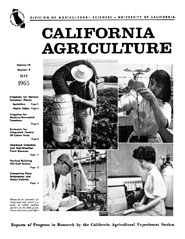


University of California
California Agriculture
|
|||
|
|||

Research on systemics for integrated pest control program in cotton involves workers in the field, greenhouse, laboratory, and office.
May 1965
Volume 19, Number 5 |
|||
|
University of California, 1301 S. 46th St., Bldg. 478 Richmond, CA
|